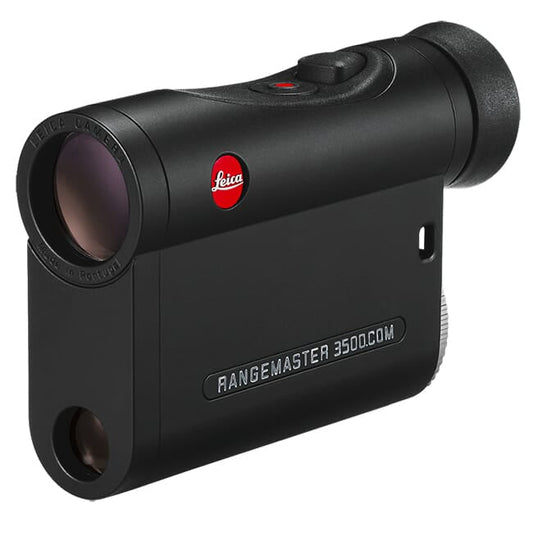

Leica CRF 2400-R Rangemaster Compact Laser Rangefinder provides accurate distance measurements up to 2400 yards, making it a reliable tool for both hunters and shooters. Its LED display features automatic brightness control, ensuring readability even in low-light conditions, such as during dusk or dawn. This rangefinder’s Equivalent Horizontal Range (EHR) technology delivers angle-compensated distance readings, essential for ethical shot placement on challenging terrains.
With a rapid measurement capability, the CRF 2400-R can update distances in just half a second, allowing quick target acquisition. The lightweight design, weighing only 6.7 ounces, combines portability with strong performance, making it easy to carry during outdoor adventures. Built with high-quality optical glass and a Class 1 eye-safe laser, this rangefinder ensures durability and safety in various field conditions.
Key Features:
- ADVANCED RANGE: Accurate measurements up to 2,400 yards for long-distance targeting.
- PRECISION EHR: Angle-compensated distance readings ideal for challenging terrains up to 1,200 yards.
- OPTIMAL VISIBILITY: LED display with automatic brightness control for clear reading in low-light conditions.
- LIGHTWEIGHT DESIGN: Ultra-portable at only 6.7 ounces, perfect for on-the-go use.
- QUICK SCANNING: Swift 0.5-second measurement updates in Fast Scan Mode.
- EYE-SAFE TECHNOLOGY: Built with a Class 1 laser that's safe for eyesight.
- QUALITY OPTICS: Premium Leica optical glass for clear, crisp viewing.
- FLEXIBLE MEASUREMENTS: Option to toggle between yards and meters for personalized usage.
Technical Specifications
| Specifications | Details |
|---|---|
| Weight | Approx. 6.5 oz |
| Dimensions | Width: 4.1", Height: 3.3", Length: 6.1" |
| Eye Relief | 15 mm |
| Field of View | 347 ft / 115 m |
| Angular Field of View | 6.5° |
| Exit Pupil | 3.4 mm |
| Twilight Factor | 13 |
| Range | 2,400 Yards |
| Objective Lens Diameter | 24mm |
| Laser | Class 1 Eye Safe |
| Angle Compensation | EHR: 1,200 Yards |
| Measurement Units | Meters and Yards |
| Beam Divergence | Approx. 0.5 x 2.5 mrad |
| Battery Type | 1 x 3 V/Lithium-type C2R |
| Monocular Details | Magnification: 7x, Objective: 24mm |
| Measuring Time | 0.5 sec |
| Magnification Range | 7x |
| Item Condition | New |
| UPC | 4022243405462 |
| MPN | 40546 |
| Product Type | Shop All Laser Range Finder |
What's in the Box?
Included in the box with the Leica CRF 2400-R Rangemaster 40546 is everything needed to start ranging immediately:
- Leica CRF 2400-R Rangemaster
- Carrying Strap
- Cordura Case
- Battery
- User Manual
Customer Reviews
“This rangefinder is quick and very accurate. Perfect for my hunting trips.”
“Lightweight and easy to use, even in low-light conditions. Highly recommend!”
“The angle compensation feature is a game-changer for ethical hunting.”
FAQ
How does the Leica CRF 2400-R perform in low-light conditions? The built-in LED display with automatic brightness control ensures clear visibility during dusk and dawn, making it an excellent choice for low-light situations.
What is the advantage of the Equivalent Horizontal Range feature? EHR provides angle-compensated distance readings, crucial for making accurate shots on sloped terrain, ensuring ethical hunting practices.
How does the CRF 2400-R compare to other rangefinders? While many rangefinders offer distance measurement, the CRF 2400-R stands out with its combination of high performance, lightweight design, and EHR technology, making it particularly suited for serious hunters and shooters.
Is the rangefinder durable enough for rugged outdoor use? Yes, the CRF 2400-R is built with high-quality materials and is designed to withstand challenging outdoor conditions, ensuring reliability and longevity.
What kind of battery does it use, and how long does it last? It operates on a 1 x 3 V lithium battery, which provides extended usage suitable for multiple outings before needing replacement.
Similar Models
Looking for more precision optics? Explore our range of Leica products, including the Leica CRF 1600-B for compact performance and the Leica Geovid 10x42 for enhanced optics. Discover our full collection for exceptional tools tailored to your shooting and hunting needs.
You May Also Like
Here’s some of our most similar products people are buying. Click to discover trending style.







